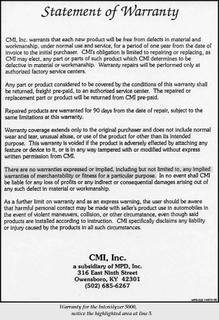PBT'S: Reliability? (part 1)

During my research on SCRAM I stumbled on some things like,RULE 702 Admitting Scientific Evidence,Bill of Rights and laws surrounding DUI.My first find was on the devices used to record Breath Alcohol Content (BrAC).Now aware that TAC is not directly related to Blood Alcohol Content (BAC),I have found that BrAC is not 100% either.(click image on the left and read the warranty)
A major problem with some machines is that they not only identify the ethyl alcohol (or ethanol) found in alcohol beverages, but also other substances similar in molecular structure. Those machines identify any compound containing the methyl group structure. Over one hundred compounds can be found in the human breath at any one time and 70 to 80 percent of them contain methyl group structure and will be incorrectly detected as ethyl alcohol. Important is the fact that the more different ethyl group substances the machine detects, the higher will be the false BAC estimate. The National Highway Traffic Safety Administration (NHTSA) has found that dieters and diabetics can have acetone levels hundreds and even thousand of times higher than that in others. Acetone is one of the many substances that can be falsely identified as ethyl alcohol by some breath machines.Another investigation found that alcohol-free subjects produced BrAC readings of .05 after consuming some bread products.Substances in the environment can produce false positives as well.An alcohol-free subject was asked to apply a pint of contact cement to a piece of plywood then apply a gallon of oil based paint to a wall.The process took approximately one hour,twenty minutes later the subject was tested with an Intoxilyzer which registered a BrAC of .12,well over the .08 limit in most states. There are a number of other products found in the environment can cause erroneous BrAC results.Including but not limited to: lacquers, paint removers, celluloid, gasoline, and cleaning fluids.Other common things that can cause false BrAC levels are blood or vomit in the subject's mouth, electrical interference from cell phones and police radios, tobacco smoke, dirt, and moisture. Temperature plays a roll as well,breath testers will give false readings if not adjusted or recalibrated to account for ambient or surrounding air temperatures,and the tempature of the subject is another issue,for each one degree of body temperature above normal will cause a substantial elevation (about 8%) in apparent BrAC.Some devices assume one to have a cell volume of blood (hematocrit) of 47%.This varies 42 to 52% in men and 37 to 47% in women.A person with a lower hematocrit will register a falsely high BrAC. Research indicates that breath tests vary at least 15% from actual blood alcohol concentration. At least 23% (that's about one out of every four) of all individuals tested will have a BAC reading higher than their actual BAC.
Result:Breathalyzers may be inaccurate and often lead to unjust fines, imprisonment, loss of employment, and other serious problems.
You can learn more at:
www.duiblog.com
reference:
Breath Analyzer Accuracy
by David J. Hanson, Ph.D.
http://www2.potsdam.edu/hansondj/DrivingIssues/1055505643.html
HOME

0 Comments:
Post a Comment
<< Home